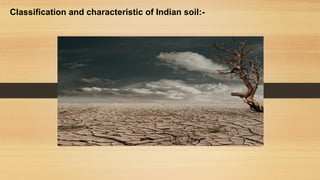
soil classification
- 1. Classification and characteristic of Indian soil:-
- 2. DEFINITION OF SOIL :- . Soil can be simply defined as a mixture of small rock particles/debris and organic materials/ humus which develop on the earth surface and support growth of plants. Major classification of soil:- 1.Alluvial soil [43%] 2.Red soil [18.5%] 3.Black / regur soil [15%] 4.Arid / desert soil 5.Laterite soil 6.Saline soil 7.Peaty / marshy soil 8.Forest soil 9.Sub-mountain soil 10.Snowfields https://www.google.com/url?sa=i&url=https%3A %2F%2Fwww.mapsofindia.com%2Fmaps%2Findi a%2Fsoilsofindia.htm&psig=AOvVaw0kEYX5Cc- PHxJTWABi5yPS&ust=1636952089979000&sourc e=images&cd=vfe&ved=0CAsQjRxqFwoTCNDd 2uqHl_QCFQAAAAAdAAAAABAD
- 3. Alluvial soil:- • Mostly available soil in India (about 43%) which covers an area of 143 sq.km. • Widespread in northern plains and river valleys. • In peninsular-India, they are mostly found in deltas and estuaries. • Humus, lime and organic matters are present. • Highly fertile. • Indus-Ganga-Brahmaputhra plain, Narmada-Tapi plain etc are examples. • They are depositional soil – transported and deposited by rivers, streams etc. • Sand content decreases from west to east of the country. • New alluvium is termed as Khadar and old alluvium is termed as Bhangar. • Colour: Light Grey to Ash Grey. • Texture: Sandy to silty loam or clay. • Rich in: potash • Poor in: phosphorous. • Wheat, rice, maize, sugarcane, pulses, oilseed etc are cultivated mainly.
- 4. Red soil:- • Seen mainly in low rainfall area. • Also known as Omnibus group. • Porous, friable structure. • Absence of lime, kankar (impure calcium carbonate). • Deficient in: lime, phosphate, manganese, nitrogen, humus and potash. • Colour: Red because of Ferric oxide. The lower layer is reddish yellow or yellow. • Texture: Sandy to clay and loamy. • Wheat, cotton, pulses, tobacco, oilseeds, potato etc are cultivated.
- 5. Black/regur soil:- • Regur means cotton – best soil for cotton cultivation. • Most of the Deccan is occupied by Black soil. • Mature soil. • High water retaining capacity. • Swells and will become sticky when wet and shrink when dried. • Self-ploughing is a characteristic of the black soil as it develops wide cracks when dried. • Rich in: Iron, lime, calcium, potassium, aluminum and magnesium. • Deficient in: Nitrogen, Phosphorous and organic matter. • Colour: Deep black to light black. • Texture: Clayey.
- 6. Arid/desert soil:- • Seen under Arid and Semi-Arid conditions. • Deposited mainly by wind activities. • High salt content. • Lack of moisture and Humus. • Kankar or Impure Calcium carbonate content is high which restricts the infiltration of water. • Nitrogen is insufficient and Phosphate is normal. • Texture: Sandy • Colour: Red to Brown.
- 7. Laterite soil:- • Name from Latin word ‘Later’ which means Brick. • Become so soft when wet and so hard when dried. • In the areas of high temperature and high rainfall. • Formed as a result of high leaching. • Lime and silica will be leached away from the soil. • Organic matters of the soil will be removed fast by the bacteria as it is high temperature and humus will be taken quickly by the trees and other plants. Thus, humus content is low. • Rich in: Iron and Aluminum • Deficient in: Nitrogen, Potash, Potassium, Lime, Humus • Colour: Red colour due to iron oxide. • Rice, Ragi, Sugarcane and Cashew nuts are cultivated mainly.
- 8. Saline soil:- • Saline soils contain neutral soluble salts of chlorides and sulfates of sodium, calcium magnesium. • The electrical conductivity of saturated extract of the soils more than 4ds/m. • ESP is less than 15 and pHs less than 8.5 because of the presence of excess salts and low amount of Na, these soils are in a flocculated state and their permebility is higher than alkali soils. • Their physical conditions good and water can pass through them. • These soils have a write crust of salts on their surface.
- 9. Peaty/marshy soil:- • Areas of heavy rainfall and high humidity. • Growth of vegetation is very less. • A large quantity of dead organic matter/humus which makes the soil alkaline. • Heavy soil with black colour.
- 10. Forest soil:- • Regions of high rainfall. • Humus content is less and thus the soil is acidic.
- 11. Sub-mountain soil:- • The soils are heterogeneous in nature • The property of soil varies with mountainous climate and altitude. • The soils comprises of high amount of humus, but are deficient in potash, phosphorus and lime. • The soils are adequate and suitable for plantation of tea, coffee, spices and tropical fruits. • The soil is loamy and silty in valley sides and coarse- grained in the upper slopes. • The soil is acidic with low humus content in the snow- covered areas. • It is fertile in the lower parts of the valleys.
